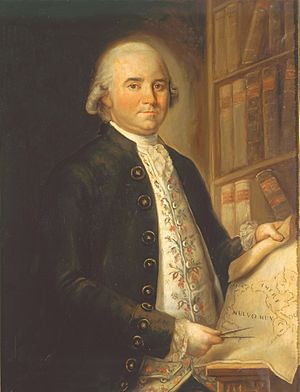Juan Bautista Muñoz facts for kids
Juan Bautista Muñoz (born June 12, 1745, in Museros, Spain – died July 19, 1799, in Madrid) was an important Spanish thinker and historian. He lived in the 1700s, a time of great change and new ideas.
Contents
Juan Bautista Muñoz's Life Story
Juan Bautista Muñoz was born in 1745 in Museros, a town near Valencia. He was the third of four sons. When his father passed away in 1751, his mother sent him to live with his uncle. His uncle, Gabriel Ferrandis, was a Dominican friar. Muñoz began his formal education at his uncle's convent in Valencia.
From 1753 to 1757, Muñoz studied at a Jesuit school in Valencia. There, he met Antonio Eximeno Pujades, a very smart person who knew a lot about many subjects. This meeting made Muñoz interested in mathematics and new ways of thinking.
Student and Teacher in Valencia
From 1757 to 1770, Juan Bautista Muñoz was at the University of Valencia. First, he was a student, and then he became a teacher. He earned his master's degree in arts and a bachelor's degree in philosophy by 1760. By 1765, he had a doctorate in theology.
Muñoz was a big supporter of the Enlightenment. This was a time when people focused on reason and new ideas. He became known at the university for disagreeing with older ways of teaching, called Scholasticism. He wanted to update what students learned to include more modern topics.
In his book, De recto philosophiae recentis in theologiae usu dissertatio (1767), Muñoz explained why modern philosophy was useful for understanding traditional theology. He also helped bring the works of other modern thinkers into the university's lessons. During this time, he also worked on editing the writings of Louis of Granada, which were published between 1765 and 1775.
Because he was a Dominican and liked new ideas, Muñoz's career grew. This happened especially after King Charles III ordered the Jesuits to leave Spain in 1767. After a short trip to Rome in 1768, Muñoz was made a professor of philosophy at Valencia in 1769.
Royal Cosmographer
On October 28, 1770, when he was only 25, King Charles III gave Juan Bautista Muñoz an important job. He was named Cosmógrafo mayor de Indias, which means "chief cosmographer of the Indies." A cosmographer was someone who studied maps, geography, and the universe. Muñoz left his teaching job in Valencia and moved to Madrid to start his new role.
This job had been created in 1571, but by Muñoz's time, its duties were not very clear. The Spanish navy had taken over many of its scientific tasks. Muñoz tried to make the job more important again. However, the position was officially ended by the king in 1783. Even so, Muñoz continued to use the title until he died in 1799.
In his role as cosmographer, Muñoz started to study history more deeply. He often had to look at old documents about Spanish America to write his reports for the Consejo de Indias (Council of the Indies). While in Madrid, he also helped with King Charles III's efforts to improve education. He wrote a book about education in 1778.
Writing the History of the New World
In the late 1700s, the published histories of the Americas in Spain were very old. The last major history book was from the early 1600s. Other countries, like Scotland, had started publishing their own new histories. For example, William Robertson's History of America came out in 1777.
When a war broke out between Spain and Britain in 1779, the Spanish government wanted its own updated history. On July 17, 1779, King Charles III officially asked Muñoz to write a full history of the Spanish conquest and settlement of the Americas. The king wanted to correct wrong stories and defend Spain's claims in America. Muñoz began collecting and studying documents from many different archives in Spain and Portugal. He wanted his history to be accurate and based on facts.
In 1784, Muñoz moved to Seville. There, he could easily access important archives, like the Casa de Contratación and the Biblioteca Colombina. Seeing how valuable it was to have all documents about the Americas in one place, King Charles III ordered the creation of the Archivo General de Indias in Seville in 1785. Many documents from other archives were sent there. Muñoz worked closely with José de Gálvez to collect and organize these incoming documents.
The first volume of Juan Bautista Muñoz's great work, Historia del Nuevo Mundo (History of the New World), was published in 1793.
Works
- De recto philosophiae recentis in theologiae usu dissertatio (1767)
- Juicio del tratado de educacion de Pozzi (1778)
- Historia del Nuevo-Mundo (1793)
See also
 In Spanish: Juan Bautista Muñoz para niños
In Spanish: Juan Bautista Muñoz para niños


